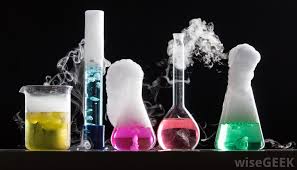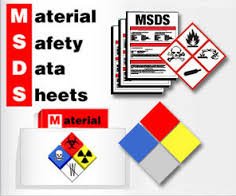Chemicals .. Beware of the risk of explosion
 Hazardous substances are any solid, liquid or gaseous substance that may harm humans or other organisms, property or the environment. Hazardous material may be radioactive, flammable, explosive, toxic, corrosive, biologically hazardous, oxidizing, caustic, pathogenic, allergenic or otherwise hazardous in certain circumstances.
Hazardous substances are any solid, liquid or gaseous substance that may harm humans or other organisms, property or the environment. Hazardous material may be radioactive, flammable, explosive, toxic, corrosive, biologically hazardous, oxidizing, caustic, pathogenic, allergenic or otherwise hazardous in certain circumstances.
Hazardous materials are defined based on the following characteristics: flammable and explosive properties, oxidation, interaction with water and air, propagation speed, degree of toxicity. It can be said that there is no safe chemical, all chemicals may be toxic and capable of causing harm or unwanted effect on the health of the individual and to varying degrees.
Classification of hazardous chemicals
Chemicals are classified according to their hazardous chemical properties into several categories according to the United Nations System for the Definition of Hazardous Substances.
- Category I: Explosives
Dangerous explosive materials have special characters to distinguish them during trading. The letters used are from A to S except for letters I, M, O, P, Q, R) where the character depends on the specific characteristics of the material.
For example, the Canadian Transport Regulations for Hazardous Substances give a description of differentiated groups:
1.1 Explosives with high-risk explosive
1.2 Explosives with high risk of ejaculation
1.3 Explosive substances with fire generation, heavy firing, but without the risk of large-scale explosion.
1.4 Risk of limited fire or fire (including munitions, most fireworks).
1.5 Non-sensitive materials with large explosion risk (explosion similar to 1.1).
1.6 Non-sensitive materials at all. - Type II: gases
This category includes compressed or liquefied gases, or dissolved under pressure, and there are subcategories of hazards to certain gases such as fish or food. It is classified as follows:
2.1 Flammable gases, gases that ignite as soon as they contact a source of ignition, such as acetylene and hydrogen.
2.2 Inert gases, non-flammable and non-toxic gases, such as nitrogen and neon.
2.3. Toxic gases, gases that cause death or serious harm to human health if inhaled, such as fluorine, chlorine and hydrogen cyanide. - Category III: Flammable liquids:
These liquids are included in one of the following groups:
- Group 1, if it has a boiling point starting at 35 ° C or less, at absolute pressure of 101,3 Kpa, and any flash point, such as diethyl ether or carbon dioxide.
- Group 2, if it has a boiling point greater than 35 ° C, at absolute pressure of 101.3 Kpa and a flash point less than 23 ° C, such as gasoline and acetone.
- Group 3, if the inclusion conditions in group 1 and 2, such as kerosene and diesel, are not met.
Class IV: Solid inflammable materials
Highly volatile solids are classified as follows:
4.1 Flammable solids, which are highly flammable and combustible, such as nitrocellulose, magnesium and matches.
4.2 Automatic combustion solids, which are naturally flammable solids such as aluminum alkylates, white phosphorus.
4.3 Hazard when wet, solids that release flammable gases when they touch water or interact violently with water, such as sodium, calcium, potassium.Category V: oxidizing agents and organic peroxides
5.1 Oxidizing agents except organic peroxides, calcium chlorite, ammonium nitrate, oxygen water, potassium permanganate.
5.2 Oxidizing and organic peroxides, organic peroxides whether liquid or solid (benzoyl peroxide, hydroxylamine).Category VI: toxic and infectious substances
This class is divided into toxins and bio-hazardous substances as follows:
6.1 A Poisonous substances that cause death or serious harm to human health if inhaled, ingested or absorbed by the skin (potassium cyanide, mercuric chloride).
6.1 B. Toxic substances harmful to human health such as pesticides, methylene chloride.
6.2 Biomaterials, WHO classified this category into A, infectious strain, B samples of virus farms, pathogens, used venous syringes.Seventh Category: Radioactive Materials
This category includes a combination of materials that emit ionizing radiation such as uranium, plutonium.Category Eight: Corrosive Materials
Materials that can dissolve organic tissues or severely corrode some metals. They are divided as follows:
8.1 Acids, hydrochloric acid, sulfuric acid.
8.2 Alkalis, Sodium Hydroxide, Potassium Hydroxide.Category 9: Miscellaneous risks
They are hazardous substances that do not have a classification such as asbestos, airbag inflators, self-propelled life jackets, dry ice.
Chemical hazards are not limited to those whose profession requires dealing with such materials as researchers, technicians and workers. A person may be exposed to chemical hazards at home due to misuse, accidental damage, or environmental pollution.
Detection of MSDS material safety data
A bulletin on the safety instructions and instructions for the material. This leaflet explains all the required information related to the chemical. The chemical supplier shall supply the facility used for these materials with the safety bulletin for each substance. A facility file containing all safety bulletins must be kept for all materials used, and all workers dealing with chemicals in the facility should have access to this file. The leaflet should also have recent data (two to three years earlier), in good condition so that it can be read and translated into the local language. The safety bulletin contains 16 parts, each part of which deals with a specific area of the chemical, as follows:
- This section includes the name of the article, the address and telephone number of the manufacturer and distributor of this article and the names of persons contacted in case of emergency.
- This section contains hazardous components

Warning labels on containers
Warning labels that contain quick information about the material and how dangerous it is. Chemical manufacturers place and install these labels on containers before leaving the factory. These labels are also the first step in identifying the hazards of the material inside the container. International warning labels are divided into three types:
- HMIS - Hazardous Material Identification System: In this system the shape of the poster is rectangular, the blue is used to identify the health hazards and the red color of the identification
The risk of ignition of the material and yellow color to identify the risk of interaction as the use of white to identify the tasks of personal protection to be used,
By means of personal protection. - NFPA - National Fire Protection Association: This system is similar to the HMIS system, where colors are used to identify hazards and numbers to define the degree of risk.
It is in a particular shape, and white is used to identify the specific hazards of the material. - RTK-Right To Know labels: The material risks in this system are written in English and any other language may be added to it.
A fee is added to the NFPA system and the distinctive colors of the hazard and the number of risks are indicated in the figures. The first aid required and the type of fire extinguishers to be used in case of fire
For this article, illustrate how to treat leakage of this substance.
The label is divided into four colors and each color identifies one of the chemicals' specific risks. Blue is the distinctive color of health hazards, the red color is the risk of ignition,
The white color identifies the specific risks for the NFPA system, while the white color is used to identify the personal protective devices to be used according to the HMIS system. And divided
Severity to five degrees: (0) There is no risk, (1) very simple gravity, (2) medium gravity, (3) high gravity, (4) very high gravity.
Health risks are divided as follows:
- The number (0) indicates the absence of any health risks of this article.
- Figure (1) indicates that this substance can cause allergies if not treated.
- Figure (2) indicates that this substance may cause harm and need urgent medical treatment.
- Figure (3) indicates that this substance may cause serious harm to the human being if exposed to it without the means of personal protection.
- The number (4) indicates that this substance may cause death or serious harm to the human if exposed to it.
The risk of ignition is divided as follows:
- Figure (0) indicates that the material is non-flammable.
- Figure (1) indicates that this material can be ignited if heated to a high temperature.
- Figure (2) indicates that this material can ignite if it is heated to a reasonable temperature.
- Figure (3) indicates that this material can ignite at all normal temperatures if the ignition source is found.
- Figure (4) indicates that this material is flammable.
The risk of interaction is divided as follows:
- Figure (0) indicates that the material is stationary and does not react with water.
- Figure (1) indicates that this material is fixed in normal conditions and becomes unstable at high temperatures and high pressures and can interact with water.
- Figure (2) indicates that this material is not fixed under normal circumstances but not to the degree that can occur as a result of its bang.
- Figure (3) This material can cause a bang or explosion and in order to do so need a large driving force or if heated in a closed container.
- The number (4) indicates that this material is very dangerous and is in a situation of explosion or explosion.
Special risks are divided as follows:
- (W) Material reacts with water.
Oxidizing substance.
Acidic acid.
Alkaline material.
COR - Combustible substance.
Radioactive material.
Personal protection measures are determined by the following characters:
- (A) Glasses should be used.
- (B) Glasses should be used + gloves.
- (C) Plastic glasses + gloves + plastic bib should be used.
- (D) The face protector + gloves + plastic bib should be used.
- (E) Plastic glasses + gloves + dust muzzle should be used.
- (F) Glass glasses + gloves + plastic bib + dust muzzle should be used.
- (G) Plastic glasses + gloves + muzzle should be used against vapors.
- (H) Plastic glasses + gloves + plastic bib + muzzle should be used against vapors.
- (i) Plastic glasses + gloves + muzzle should be used against dust and vapors.
- (J) Plastic glasses + gloves + plastic bib + muzzle should be used for vapors and dust.
- (K) Respiratory mask should be used with air supply hose + gloves + full protection suit + long boots.
- (X) You should ask your supervisor about the type of personal protection you should use to protect against the risks of this material.

Congratulations @majidvx! You have received a personal award!
Click on the badge to view your Board of Honor.
Do not miss the last post from @steemitboard:
SteemitBoard and the Veterans on Steemit - The First Community Badge.
Congratulations @majidvx! You received a personal award!
You can view your badges on your Steem Board and compare to others on the Steem Ranking
Vote for @Steemitboard as a witness to get one more award and increased upvotes!
The most logical option would be not just to look for such a passport, but to contact those who collect and distribute such SDS, but also provide the most up-to-date versions of them directly and in the fastest time, thanks to such as https://sdsmanager.com/uk/ , many companies can increase their productivity and be sure that All specifications are exactly as advertised!